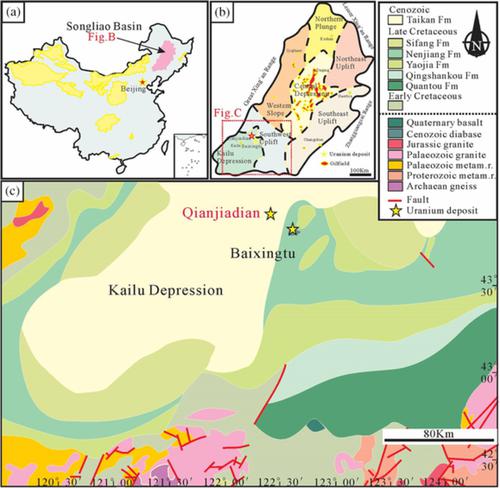Characteristics of fluid inclusions in the sandstone‐hosted Qianjiadian uranium deposit, southwest Songliao Basin, northeastern China: Implications for the nature and evolution of ore‐forming fluids
IF 0.8
4区 地球科学
Q3 GEOLOGY
引用次数: 2
Abstract
The Qianjiadian deposit is a typical sandstone‐hosted uranium deposit that is hosted mainly in sandstone and siltstone of the Lower Cretaceous Yaojia Formation, located within the transition between the Kailu Depression and Jiamatu Uplift in the Songliao Basin, northeastern China. We studied the geological characteristics of this deposit, and analysed the mineralized sandstone by scanning electron microscopy (SEM) and electron probe microanalysis (EPMA) to identify the host minerals of fluid inclusions associated with uranium mineralization and describe their petrographic characteristics. In addition, this research investigated the origin of ore‐forming fluids and the relationship between petroleum fluids and uranium mineralization, based on the following findings. (1) EPMA and SEM data show that uranium minerals are hosted mainly in hydrothermal quartz (HQ) within sandstone cement, which indicates that uranium minerals co‐precipitated with HQ. (2) The fluid inclusions in the HQ show low homogenization temperatures (102.5–169.5°C) and low salinities (1.7–6.1 wt%). In contrast, aqueous inclusions in quartz overgrowths show lower temperatures (60.5–117°C) and higher salinities (4.2–8.7 wt%). (3) Petroleum fluids trapped in HQ homogenize fluid and those along healed microfractures in quartz overgrowth or plagioclase overgrowths at ~70–80°C, those trapped in present‐day organic inclusions at ~85–95°C, and at the boundary of detrital mineral grains show higher homogenization temperatures (~135–145°C). These results indicate that the hydrothermal quartz cement is associated with uranium mineralization, and the ore‐forming fluid of Qianjiadian sandstone‐hosted uranium deposit are characterized by low‐temperature, low‐salinity hydrothermal fluids, and the changes of temperature and salinity of hydrothermal fluids may not be intimately associated with uranium mineralization.

松辽盆地西南部前家店砂岩型铀矿床流体包裹体特征及其成矿流体性质与演化意义
黔家店铀矿床位于松辽盆地开鲁坳陷与贾马图隆起的过渡带,是典型的砂岩型铀矿床,主要赋存于下白垩统姚家组砂岩和粉砂岩中。研究了该矿床的地质特征,利用扫描电镜(SEM)和电子探针显微分析(EPMA)对矿化砂岩进行了分析,确定了与铀矿化有关的流体包裹体的寄主矿物,并描述了其岩石学特征。此外,本研究还探讨了成矿流体的成因以及石油流体与铀矿化的关系。(1) EPMA和SEM数据表明,铀矿物主要赋存于砂岩胶结区内的热液石英(HQ)中,表明铀矿物与HQ共沉淀。(2) HQ流体包裹体均质温度低(102.5 ~ 169.5℃),盐度低(1.7 ~ 6.1 wt%)。相比之下,石英过度生长中的水包裹体温度较低(60.5-117℃),盐度较高(4.2-8.7 wt%)。(3)在~70 ~ 80℃时,石英过度生长或斜长石过度生长中,HQ均质流体和沿愈合微裂缝的石油流体,在~85 ~ 95℃时,现今有机包裹体中,以及碎屑矿物颗粒边界处的石油流体均质温度较高(~135 ~ 145℃)。这些结果表明,热液石英胶结物与铀矿化有关,前家店砂岩型铀矿床成矿流体为低温、低盐度热液流体,热液流体的温度和盐度变化可能与铀矿化关系不密切。
本文章由计算机程序翻译,如有差异,请以英文原文为准。
求助全文
约1分钟内获得全文
求助全文
来源期刊

Resource Geology
地学-地质学
CiteScore
2.30
自引率
14.30%
发文量
18
审稿时长
12 months
期刊介绍:
Resource Geology is an international journal focusing on economic geology, geochemistry and environmental geology. Its purpose is to contribute to the promotion of earth sciences related to metallic and non-metallic mineral deposits mainly in Asia, Oceania and the Circum-Pacific region, although other parts of the world are also considered.
Launched in 1998 by the Society for Resource Geology, the journal is published quarterly in English, making it more accessible to the international geological community. The journal publishes high quality papers of interest to those engaged in research and exploration of mineral deposits.
 求助内容:
求助内容: 应助结果提醒方式:
应助结果提醒方式:


